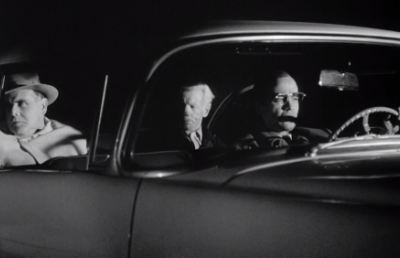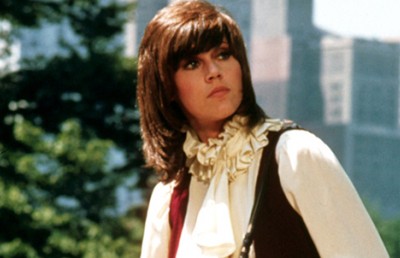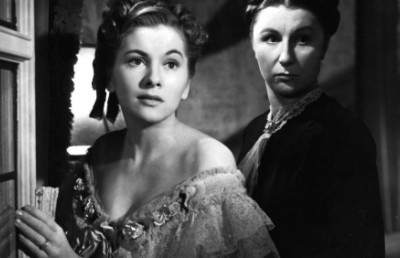The Woman in the Window and Scarlet Street (Fritz Lang, 1944/1945)
_1000_420_90_c1.jpg)
Made back-to-back, led by the same trifecta of actors and following a similar trajectory in their morality tale storylines – that of a middle-aged married man (Edward G. Robinson) stumbling across a seeming chance at attaining the physical embodiment of his most illicit desire (namely, Joan Bennett), only to be sucked inexorably into a spiraling web of deceit and extortion, in large part led by the greedy plans of an amoral hustler (character actor Dan Duryea, who – with lean physique, sleazy sex appeal and that high-pitched mannered delivery he brings with such unsavoury relish — has to be considered the crown prince conman of Hollywood noir) – the double bill of The Woman in the Window and Scarlet Street provides a really unique glimpse at two uncannily similar stories and productions being filmed twice (in a row), by the same director, but with the results being less interesting for their similarities then for just how wildly they reveal themselves in conflict. They’re mirroring images, yes, but distorted ones, with the mirror straight out of a fun-house, with the first (Woman in the Window) being a clear producer-driven vehicle with its eyes on the prize of commercial success… and the second (Scarlet Street) a darker, more uncompromising effort, with the same director, yes, but freed up and on a feverishly personal mission.
Forced to leave behind his staggeringly brilliant German career with the rise of Hitler, Lang’s prolific Hollywood output might have still been quite good (including his two first brilliant early-noir and expressionism-tinged stabs out of the gate, the social dramas You Only Live Once and Fury), just not as transcendent as his grandiose silent visions were (kind of a high bar, though), and the box office returns, alas, were often weak, leaving fed-up American producers no good reason to put up with the way over-the-top demands of the megalomaniacal filmmaker (think Mabuse making movies and you get a sense of Lang’s production approach)… and the constant abuse he would infamously unleash on everyone around him.
_571_463_90.jpg)
Fateful meeting between Joan Bennet and E.G. Robinson
So, when the slightly-cowed Lang (as in, focusing his raving vitriol on cast and crews only) found himself on a (ultimately short) hot box office streak (including Woman in the Window) and feeling emboldened by this rare window (sorry, couldn’t help the pun) of financial success, he went at it with ‘Scarlet”, going wildly over-budget and over-schedule, causing unrepentant chaos all around him (other than with Bennett, who he was clandestinely getting it on with on the side, behind the back of her husband – namely, Walter Wanger, who happened to be the producer of the film! – Ah, Fritz… gotta hand it to him, for an ogre-ish-looking lunatic with a ridiculous monocle, he did well with the leading actresses of the day… and did it dangerously!)… and, likely not coincidentally, managed to bring some of the best of his dark touches and inspired cinematic idiosyncrasies, turning the original, well-constructed Hollywood noir tale… into one rife with insidious and selfish characters masking their identities (it’s a Lang vision, after all), as they traverse a landscape dripping with madness, paranoia… and a deep sense of nihilism (no surprise, alas, the audience didn’t quite take to this vision as they had with The Woman in the Window).
The more daring approach of Scarlet Street is revealed almost immediately through the introduction of our main protagonist, with the Robinson character transformed from the accomplished college professor (and comfortable family man) Richard Wanley of Woman in the Window, who feels in control even as the events begin to weave against him, into the middling, weary figure of Christopher Cross (okay, the name might be a bit too on the noise), a failed artist and long-time cashier clerk at a large corporate firm, surrounded always by successful businessmen but yet never part of their world (a mere handler of their wealth but never able to share in it).
_440_431_90.jpeg)
Announcing his intentions immediately, the director opens the film on one of his familiar visual motifs; a group of mostly faceless aging men sitting about a large oval table, the heavy smoke from their cigars wafting about, with all of them, it turns out, there to celebrate Cross for his twenty-five years of service. After receiving a gold watch as a gift (a poignant reminder, we’ll come to realize, of time passing, of unfulfilled dreams), Cross easily sneaks out, forgotten and unnoticed, as the others gather at the window to lasciviously watch their boss’ beautiful mistress arrive to retrieve him.
Where the urban landscape that the professor leisurely strolls through in The Woman in the Window on his way home from a comfortable evening at his private men’s club has the sense of the utilitarian (with much of it looking a lot like a Hollywood set, which it likely was), the dark rainy streets of Scarlet Street are much more evocative, with Lang’s wider shots creating the impression of Cross as a tiny figure engulfed, shrouded in darkness, surrounded by potential hidden menace.
While the pilgrimage of Wanley, with the suddenly free professor, his wife and children away for the week, whimsically – and arrogantly (bound up in self-assuredness of his standings that nothing could possibly go wrong if he doesn’t will it, a lesson in humility he’ll learn, even if it’s entirely backtracked by the conclusion of the film) — able to engage with his ‘object of desire’ by sheer coincidence (in a nicely constructed bit of having the female portrait — the ‘woman in the window’ — that he’s casually smitten with literally coming to life in non-supernatural fashion — proving, even in a standard Hollywood production, and on his best behaviour, Lang had more than his share of clever cinematic flourishes to give), the oppressive walk home for Cross, meanwhile, is a descent into dank Langian terrain; the wet streets, the looming shadows, a brief exchange with an unfriendly authority figure, and the growing prioritization of unsettling sound cues – it’s almost as if this Robinson character isn’t just traversing the concrete, but an entire continent, and a cinematic time, ending up transported back to the streets created by Lang for his early German years, the crime-infested and despairing landscapes of his early sound masterpiece M and his first Dr Mabuse films.
_440_339_90.jpg)
With the entire soundtrack consumed by the unsettling screech of a passing El train above, Cross stumbles upon a shocking beating on the otherwise empty street, an attack that the diminutive man feels compelled to involve himself in… culminating in a moment of pure silent cinematic mastery… with the cowering Cross slowly lowering his raised arms (surprised no counter-attack has come), to discover between them the image of a damsel in distress, as if conjured up from his own desires… with his growing smile revealing a hopefulness, yes… but also something darker… and more predatory.
The characters that make up The Woman in the Window are relatively straightforward in their moral positions. Bennett’s Alice Reed, the clandestine kept woman of a wealthy married man Claude Mazard (his initial ‘C.M’ ultimately playing an important part of the ensuing suspense), remains unambiguously on Wanley’s side, working with him to cover up the aftermath of the night of their fateful meeting in which things went terribly awry, leading to a violent murder – and in dealing with the ensuing blackmail from Mazard’s corrupt fired ex-cop bodyguard (Duryea, of course) who threatens to destroy Wanley’s carefully constructed life. The motivations and emotional makeup of the figures in Scarlet Street, on the other hand, are murkier, less comforting.
_630_473_90.jpg)
The easy to despise Dan Duryea with Joan Bennett
Bennett’s new part, Kitty Marsh, is as a conniver, and likely prostitute (in as much as the censorship of the day would allow allusions to the profession… but they’re certainly there), no longer reluctantly kept by a wealthy man, but now willingly in an ugly co-dependent relationship with low-life street hustler and pimp Johnny Prince (yep, Duryea) – the very man that Cross initially saw beating Kitty on the street, though he doesn’t realize it was Prince (with deliberately obscured truth a familiar motif to the director that bleeds all over the film, across every relationship in it) — and her connection with Cross becomes one of scamming every penny she (and Prince) can get out of the pathetically desperate man (and a jealously obsessed one – to the point of possibly being dangerous – something she fails to realize… until it’s too late), as she is mistakenly convinced Cross is a wealthy man, as he has deceived her in a sad attempt to make himself more desirable.
While Wanley’s established existence (and patriarchal position) is what’s under threat by ‘straying’ (with all the chances of things going wrong — including murder! — that the film wags its finger in warning of, as an early version of those conservative and reactionary – yet still well made and fun — neo-noir movies so popular in the 80’s, like Jagged Edge and Fatal Attraction), for the hen-pecked Cross, living in a home where the value of his paintings and societal standing are constantly ridiculed by his shrill wife, the figure of Kitty (delusionally) represents escape. Cross is almost literally de-masculinized, wearing a cooking robe as he obediently cleans the dishes each night, loomed over by a large portrait photo of the powerful presence of his wife’s previous husband, the heroic deceased Chief of Police (though we’ll eventually learn this isn’t exactly true either).
Littered with characters pretending to be something they’re not, at social status they don’t have, concocting elaborate situations (including a fake death!) to better themselves – disguises and false identities so abound in the film it almost feels like we’ve walked into a 60’s Doctor Mabuse film, minus the death rays and espionage (no surprise, since Lang started the wonky franchise) — with human relationships shown to be constructed on everything from compulsive desire, blackmail and hate, and never on love, Scarlet Street is Lang full-blast, his cynical, paranoia-fueled world-view on full display. Even in the relentless stabbing murder centerpieces of the two films (again, directly mirroring each other), where in Woman in the Window the act is one of understandable (if still shocking) self-defence, in Scarlet Street, it’s a far more shocking act of transgression (and a tawdry one too — while I’ve read there were battles with the censors over the film, it’s still a wonder it made it past the censors even in the shape it did).
_630_473_90.jpeg)
Pure Langian Noir imagery. Could be a shot out of M.
Having experienced first-hand the stark economic turmoil in Germany that led directly to the rise of Hitler, Lang’s Scarlet Street presents unjust economic disparity as the underlying culprit for fomenting the desperation and resentment that turns violent; that allow those at the top to touch dreams (Cross’ boss, his wealth allowing him to attain the image of female perfection and happiness, while also affording him the easy graciousness towards the Cross character by not firing him when he realizes he’s been stealing money from the firm to pay for Kitty’s rent, and even in The Woman in the Window, with the professor able to sit comfortably in his men’s club chair imagining playing out his illicit desires but happy enough not to need to truly act on them) and leave the masses beneath to fight viciously for the crumbs.
Robinson’s professor in The Woman in the Window ends up revealed as a heroic placeholder for good, bourgeois values, while his Cross in Scarlet Street… a tragic victim, punished for daring to desire more than his ‘position’ allowed.
Where The Woman in the Window, with its final jaw-dropping cop-out of a twist ending (one admirably constructed on the production side, yet so narratively unforgivable I can’t possibly fathom the nihilist Lang was ever remotely happy with it), that lets the Robinson character – and the audience — entirely off the hook, with the tale revealed as a privileged man’s brief flight of fantasy, allowing him to return unpunished to his comfortable bourgeoise life, is termed a ‘noir fantasy’, the desperately haunting, beautifully captured final moments of Scarlet Street, with Cross having gotten away with a rage-filled murder (through an ironic twist that leaves the Duryea character implicated – again, in a perverse mirror twist on _ The Woman in the Window_ as he’s also implicated in that one), but now forever emotionally destroyed by what he has done – left destitute, homeless and suicidal, punished for our shared sins of desire (like, well, you know, little ol’ Christ on the cross) — Scarlet Street transformers the tale into profound ‘noir tragedy’.
The Woman in the Window may be a good one (with an unfortunate bad ending)… but it’s Scarlet Street, with the monster Lang having temporarily broken from his chains, that ends up not only a brilliant example of cinema noir, but an auteur film tour-de-force.




-small_400_258_90_s_c1.jpg)









